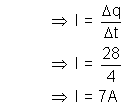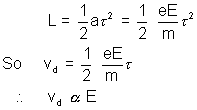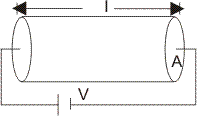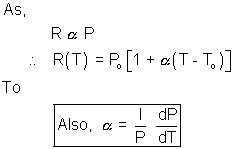Electric Current - 1
We all must be families with the team electric current. We think who simple it is. But when even for a single moment we try to analyze actually what it is, how is it generated then we realize that team and making it so simpler to us. Now a days every single thing is an application of current and electricity.
Conductor for and time is called electric current
Where dq is the charge flown through a cross section area conductor in time dt. It is also called instantaneous current I this dt - 0.

Where q is the charge flown in a finite time t. S.I unit of electric current is Ampere (A).

Illustration - 1. The current in a wire varies with time according to the relation.
I=(3+2t)A
(a) How many coloumbs of charge pars a cross section of the wi in the time interval between t=0 and t=4s ?
(b) What constant current would transport the same charge in the same time interval ?
Ans :-(a) We know that,

(b) Let the new current be I.

Current density  is defined as.
is defined as.

Note that it is a vector quantity.
The direction of  is same as direction of current. If a uniform current i moves over an area S and is in same direction as area vector then,
is same as direction of current. If a uniform current i moves over an area S and is in same direction as area vector then,


So i is a resulting from the dot product of  and
and  .
.
Drift Velocity - It is defined as.

Where e = electron charge.
m = mass of electron
E = Electric field
 = average collision time.
= average collision time.
to the field direction. But in their way they collide with of positive ions. So they follow a very zig-zag motion, hence length that they drift even in a long interval in small let this length be 'l' and time interval = ' '. then -
'. then -

Now the electron moves under the influence of an electric field, Hence

Where 
depends on temperature and material of conductor
Current and drift velocity :- We can express a relation in current and drift velocity  as,
as,

where n = Moving charged particles per unit volume.
A = Area of cross section perpendicular to current flows.
Dumb Question - 3. What is the direction of current density ?
Ans:-  being a vector have a direction similar to
being a vector have a direction similar to  .
.
Dumb Question - 4. It a charge (q) is rotating with frequency f. What is the current ?
Ans :- I = qf because the units of current is amp = coloumb/s and qf constitutes this unit.
to electric field ( ) with constant of proportionality being resistivity of (P) of the material, at a constant temperature.
) with constant of proportionality being resistivity of (P) of the material, at a constant temperature.
This relationship is called ohm's law.

Where V is the potential difference across the conductors.

placing J and E is equation (1) -

now, 
this  or resistance
or resistance 

which is more general form of ohm's law.
Question :- Is ohm's law for all materials ?
Ans :- The current density  in a conductor depends on the electric field
in a conductor depends on the electric field  and on the properties of the material. In general this dependence is quiet complex But for same materials, especially metals, at a constant temperature ohm's law holds good.
and on the properties of the material. In general this dependence is quiet complex But for same materials, especially metals, at a constant temperature ohm's law holds good.
Illustration - 2. If a wire of resistance R is streched to double its length. What will be new resistance ?
Ans :- Suppose initial radius of wire be r, final be r' and new length be l' (= 2l)
Now, after streching volume of wire will not change :-

 New changed Area =
New changed Area =  where A = initial area
where A = initial area
 New resistance
New resistance 
Temperature dependence of resistivity and resistance.
The resistivity of a metallic conduct or nearly increases with increase in temperature.
Reason -
With the increase in temperature the ions of conductor vibrate with greater amplitude and the collision between electrons and ions be come more frequent.

where P0 = resistivity at a reference temperature.
T0 = The factor  is called the temperature co-efficient of resistivity.
is called the temperature co-efficient of resistivity.
The resistance of a given conductor depends on P, A and l. Ad temperature changes A and l also changes but these changes are quiet small and thus  may be treated as constant.
may be treated as constant.

KIRCHOFF'S LAWS
(1)Junction law
It states that the net current entering a junction is equal to net current exiting that junction.
Or, Algebric sum of the current is into any junction is zero.

In this fugure,
i1 + i2 = i3 + i4 + i5
2) Voltage/Loop Law
It states that algebric sum of the potential drop around any closed path is zero.
Sign Convention:
When we travel through a source in the direction from to+, the voltage is considered to be positive, when we travel from + to.
For Battery

 = VB - VA = + E
= VB - VA = + E

 VB - VB = - t
VB - VB = - t
For resistance

 = VB - VB = - IR
= VB - VB = - IR

 VB - VA = + IR
VB - VA = + IR
Dumb Question - 7. What are the basic principles on which kirchoff's laws are based ?
Ans :- Kirchoff's junction rule basically supports the law of conservation of change. On the other hand, kirchoff's second law that is kirchoff's voltage rule or kirchoff's loop rule is based on the law of conservation of energy.